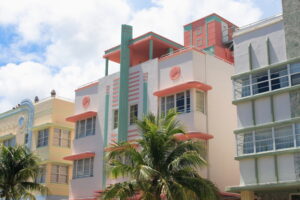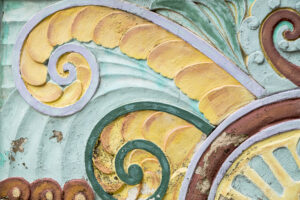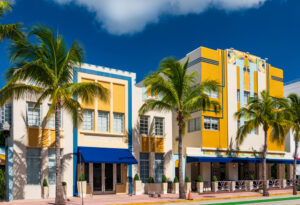This Month in Miami Beach: The Business of Preservation Begins (May 14, 1979)
On May 14, 1979, the Miami Beach Art Deco Historic District was officially listed on the United States National Register of Historic Places, marking a major milestone not just for the city, but for architectural preservation nationwide. What made the designation so special? It was the first district composed primarily of twentieth-century architecture, largely constructed in the 1930s and 1940s, to receive this national recognition.
 Characterized by pastel colors, porthole windows, and sleek, geometric lines, Miami Beach’s Art Deco buildings offer more than just vintage charm; they tell a story of resilience, reinvention, and iconic style. The designation helped save many of these structures from demolition and cemented Miami Beach as a global capital of design.
Characterized by pastel colors, porthole windows, and sleek, geometric lines, Miami Beach’s Art Deco buildings offer more than just vintage charm; they tell a story of resilience, reinvention, and iconic style. The designation helped save many of these structures from demolition and cemented Miami Beach as a global capital of design.
The moment also triggered an economic transformation.
 As the buildings were restored and reimagined, the Art Deco District became a magnet for investment and tourism. Developers saw opportunity in the preservation wave and began reviving once-fading hotels into stylish, sought-after destinations. By the late 1980s and early 1990s, visionaries like Tony Goldman had helped turn South Beach into a cultural and commercial hotspot. Celebrities moved in, major events took root, and the district’s neon glow became one of the most recognized skylines in the world.
As the buildings were restored and reimagined, the Art Deco District became a magnet for investment and tourism. Developers saw opportunity in the preservation wave and began reviving once-fading hotels into stylish, sought-after destinations. By the late 1980s and early 1990s, visionaries like Tony Goldman had helped turn South Beach into a cultural and commercial hotspot. Celebrities moved in, major events took root, and the district’s neon glow became one of the most recognized skylines in the world.
By 2023, Greater Miami and Miami Beach welcomed over 27.2 million visitors, generating an estimated $21.1 billion in spending. Tourism contributed nearly $30 billion in overall economic impact and over $19 billion in gross domestic product, representing 9% of Miami-Dade County’s total GDP. The industry supported more than 200,000 jobs, driving $11 billion in wages across the county.
 Today, the Art Deco District continues to draw visitors from around the world and remains a cornerstone of the city’s cultural and economic identity. Not bad for buildings that were once considered too new to be historic.
Today, the Art Deco District continues to draw visitors from around the world and remains a cornerstone of the city’s cultural and economic identity. Not bad for buildings that were once considered too new to be historic.